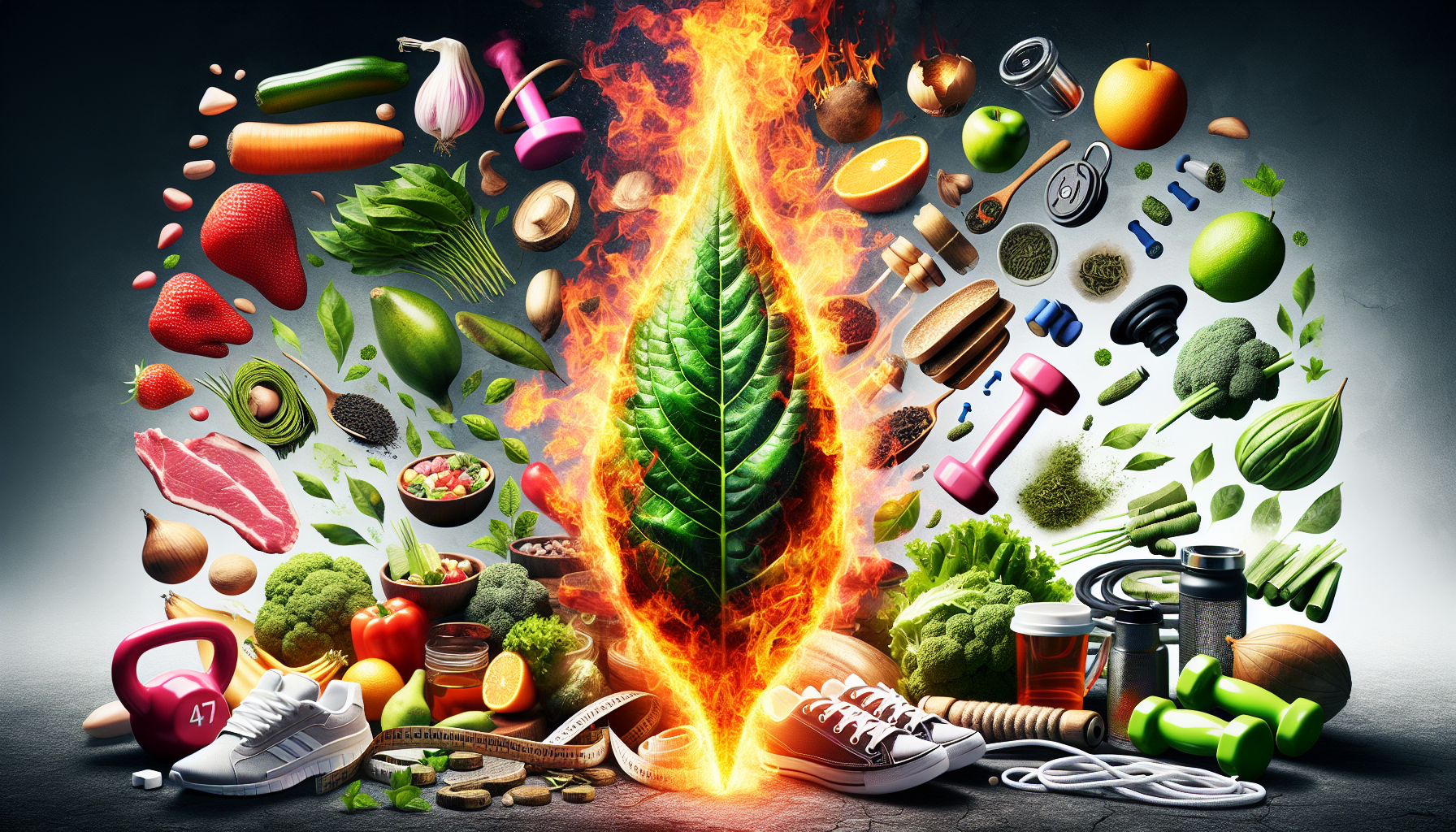
Have you ever wondered what burns fat the fastest? In our quest for achieving a healthy and fit body, this question often arises. We all want to know the secret to shedding those extra pounds efficiently. From high-intensity workouts to restrictive diets, there are various methods out there claiming to be the quickest fat-burning solution. In this article, we will explore different factors that can contribute to burning fat at a faster rate and provide you with valuable insights and tips to help you reach your weight loss goals. So, get ready to discover the truth behind what really burns fat the fastest!

What Burns Fat The Fastest?
When it comes to burning fat, there are several strategies that can help you achieve your goals. From understanding your metabolism to incorporating high-intensity interval training (HIIT) and strength training into your routine, there are various ways to maximize fat burning. Additionally, implementing a calorie deficit, following a healthy diet, consuming protein-rich foods, and incorporating caffeine and green tea into your routine can also contribute to your fat loss journey. To top it off, proper hydration and stress management play crucial roles in optimizing fat burning. Let’s dive into each of these aspects and explore how they can help you burn fat the fastest.
1. The Role of Metabolism
1.1 Understanding Metabolism
Metabolism refers to the processes in your body that convert food into energy. It is a complex system that involves various chemical reactions. Understanding how your metabolism works is essential when it comes to burning fat. Metabolism can be influenced by factors such as age, gender, genetics, and muscle mass. By gaining a better understanding of your metabolism, you can make informed choices and implement strategies to boost fat burning.
1.2 Factors Affecting Metabolism
Multiple factors can affect your metabolism. Age is one of the most significant factors, as metabolism tends to slow down as you get older. Genetics also play a role, as some individuals naturally possess a faster metabolism than others. Gender can impact metabolism too, with men typically having a greater muscle mass and higher metabolic rate compared to women. Furthermore, muscle mass has a significant influence on metabolism, as muscles burn more calories than fat. By becoming aware of these factors, you can tailor your fat loss strategies accordingly.
2. High-Intensity Interval Training (HIIT)
2.1 Introduction to HIIT
High-Intensity Interval Training, or HIIT, is a workout technique that involves short bursts of intense exercise followed by periods of rest or lower-intensity activity. This type of training can be highly effective in burning fat due to its impact on your metabolism. The intense bursts of exercise increase the number of calories burned during the workout, and the elevated metabolic rate can continue for hours after the session.
2.2 Benefits of HIIT
HIIT offers numerous benefits beyond fat burning. It can improve cardiovascular fitness, increase muscle strength, and enhance overall endurance. The flexibility of HIIT workouts also allows for customization to your fitness level and preferences. Whether you prefer running, cycling, or bodyweight exercises, HIIT can be tailored to suit your needs and help you burn fat efficiently.
2.3 HIIT Workouts
There are endless possibilities when it comes to HIIT workouts. Some popular examples include sprint intervals, kettlebell circuits, and Tabata workouts. Sprint intervals involve alternating between maximum effort sprints and low-intensity recovery periods. Kettlebell circuits incorporate different exercises using a kettlebell, targeting multiple muscle groups while keeping your heart rate elevated. Tabata workouts consist of 20 seconds of high-intensity exercise followed by 10 seconds of rest, repeating for multiple rounds. Choose a HIIT workout that suits your preferences, fitness level, and equipment availability to maximize fat burning.
3. Strength Training
3.1 Importance of Strength Training
Strength training, also known as resistance training, involves any exercise that challenges your muscles. While cardio exercises are great for burning calories, strength training plays a crucial role in fat burning due to its effect on muscle mass and metabolism. By incorporating strength training into your routine, you can build lean muscle, which helps to increase your metabolic rate and burn more calories even at rest.
3.2 Benefits of Strength Training
Apart from boosting your metabolism, strength training offers numerous benefits. It can help improve overall body composition, increase bone density, enhance joint stability, and improve overall functional strength. Additionally, strength training can contribute to improved insulin sensitivity and better glucose control, making it an essential component for overall health and fat burning.
3.3 Effective Strength Training Exercises
There are countless strength training exercises to choose from, depending on your goals and equipment availability. Some effective exercises include squats, lunges, deadlifts, push-ups, rows, and overhead presses. It’s crucial to ensure proper form and technique to reap the maximum benefits and minimize the risk of injury. Consider working with a certified personal trainer to create a customized strength training program that targets your specific fat loss goals.

4. Calorie Deficit
4.1 Understanding Calorie Deficit
In simple terms, a calorie deficit occurs when you consume fewer calories than your body requires to maintain its current weight. This deficit forces your body to tap into its fat stores for energy, resulting in weight loss and fat burning. Understanding and implementing a calorie deficit is crucial for effective fat loss.
4.2 Implementing Calorie Deficit
To implement a calorie deficit, you need to calculate your daily caloric needs and then consume fewer calories than that number. This can be achieved through a combination of diet and exercise. It’s important to create a modest calorie deficit to ensure sustainable weight loss and avoid potential negative effects on your metabolism and overall well-being.
4.3 Combining Calorie Deficit with Exercise
While a calorie deficit alone can lead to weight loss, combining it with exercise can further enhance fat burning. Cardiovascular exercises can help create an additional calorie deficit and increase your overall energy expenditure. By incorporating strength training alongside cardio, you can amplify the calorie-burning effect and build lean muscle mass, which in turn increases your resting metabolic rate.
5. Healthy Diet
5.1 Importance of a Healthy Diet
A healthy diet is the foundation of any fat loss journey. While exercise helps create a calorie deficit, the quality of the calories you consume is equally important. A nutritious and well-balanced diet provides your body with the necessary nutrients to function optimally and supports your fat loss goals.
5.2 Foods that Promote Fat Burning
Certain foods have been found to promote fat burning due to their nutrient content and thermogenic properties. Examples include lean proteins, fruits and vegetables, whole grains, healthy fats, and high-fiber foods. Incorporating these foods into your diet can help you feel fuller for longer, maintain a healthy metabolism, and support energy expenditure.
5.3 Meal Planning and Portion Control
Meal planning and portion control are essential aspects of a healthy diet. By planning your meals in advance, you can ensure you have nutritious options readily available and avoid impulsive food choices. Portion control helps prevent overeating and allows you to stay within your caloric goals. Consider using smaller plates, measuring your food, and being mindful of your hunger and fullness cues to maintain a balanced and sustainable diet.
6. Protein-Rich Foods
6.1 Benefits of Protein for Fat Loss
Protein is an essential macronutrient that plays a crucial role in fat loss. It is known to increase satiety, reduce hunger cravings, and aid in muscle recovery and repair. Consuming an adequate amount of protein can help preserve lean muscle mass during a calorie deficit and support optimal fat burning.
6.2 Protein-Rich Foods to Include in Your Diet
Including protein-rich foods in your diet is essential for fat loss. Options such as lean meats, poultry, fish, eggs, dairy products, legumes, and plant-based proteins like tofu and tempeh are excellent sources of protein. Aim to include protein in every meal and snack to maximize its benefits in supporting your fat loss goals.
7. Caffeine and Green Tea
7.1 How Caffeine Boosts Fat Burning
Caffeine is a stimulant that can increase your metabolic rate and enhance fat burning. It stimulates the central nervous system, leading to increased energy expenditure and the release of fatty acids from fat cells. Incorporating caffeine into your routine can provide an additional boost to your fat loss efforts.
7.2 Benefits of Green Tea for Fat Loss
Green tea contains various compounds, including catechins and caffeine, that have been shown to promote fat oxidation. These compounds can increase metabolism, enhance fat burning, and improve overall fat loss. By including green tea in your diet, either as a beverage or as a supplement, you can potentially accelerate your fat burning process.
8. Proper Hydration
8.1 Importance of Hydration for Fat Loss
Proper hydration is often overlooked but plays a crucial role in fat loss. Staying hydrated is essential for optimal metabolism, digestion, and overall bodily functions. Water is also known to promote satiety, reduce cravings, boost energy levels, and support physical performance during exercise.
8.2 Recommended Hydration Strategies
To ensure proper hydration, aim to drink an adequate amount of water throughout the day. The general recommendation is to consume at least 8 cups (64 ounces) of water per day. However, individual needs may vary based on factors such as activity level, climate, and overall health. Carry a water bottle with you, set reminders to drink water, and listen to your body’s signals of thirst to maintain proper hydration.
10. Stress Management
10.1 Connection Between Stress and Fat Storage
Managing stress is often overlooked but plays a significant role in fat loss. Chronic stress can lead to increased cortisol levels, which can promote fat storage, particularly around the abdominal area. By managing and reducing stress levels, you can optimize your body’s fat-burning potential.
10.2 Techniques to Reduce Stress
Implementing stress management techniques can be beneficial for both your overall well-being and fat loss goals. Some effective techniques include regular exercise, practicing mindfulness and meditation, getting enough sleep, engaging in hobbies, socializing, and seeking support from friends, family, or professionals. Find what works best for you and make stress management a priority in your fat loss journey.
In conclusion, to burn fat most effectively, it’s important to consider multiple factors and implement various strategies. Understanding your metabolism, incorporating high-intensity interval training (HIIT) and strength training, creating a calorie deficit, following a healthy diet, consuming protein-rich foods, incorporating caffeine and green tea, maintaining proper hydration, and managing stress all play important roles in optimizing fat burning. By adopting these strategies, you can enhance your fat loss journey and achieve your desired results faster and more efficiently. Remember to consult with a healthcare professional or certified fitness trainer to ensure that these strategies align with your individual needs and goals. Good luck on your fat loss journey!













Leave a Reply